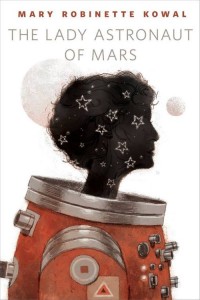 Title: The Lady Astronaut of Mars
Title: The Lady Astronaut of Mars
Author: Mary Robinette Kowal
Publisher: Print Version by Tor Books in September 2013
Source: Tor.com
Thirty years ago, Elma York led the expedition that paved the way to life on Mars. View Spoiler »
Some information about The Lady Astronaut of Mars: in case you haven’t heard, this little gem won the 2014 Hugo Award for Best Novelette. Cool right? Now, what the hell’s a novelette? I’m not too proud to admit that I had to look it up. Apparently, a novelette is longer than a short story and shorter than a novella. To qualify for the Hugo Best Novelette category, the nominated work must be between 7,500 and 17,500 words. The more you know and all that.
The Lady Astronaut of Mars takes place on the titular planet, now a colony of Earth. It wouldn’t be good hard SF if it didn’t deal with issues of colonialism, in my mind.Humans have been there for about a generation, and it’s clear that this new environment has already had an impact on human physiology. While Elma was considered a very tall woman on Earth, on Mars her stature is indicative of somebody Earth born. Those born on Mars are considerably taller. I loved the fact that despite its teensy weensy size, The Lady Astronaut of Mars still had these subtle elements of world building.
I loved how Kowal incorporated Dorothy from The Wizard of Oz into her novelette; Dorothy is Elma’s doctor, and she performs the physical evaluation that Elma must undergo before she’s possibly sent back into space. In this tale, Dorothy’s world is turned upside down not by a tornado, but by the debris from a fallen rocket. In the blink of an eye Dorothy’s world had shifted on its axis and all that she once knew was gone. It’s not hard to see why Kowal chose Dorothy of all literary characters: alone in an unknown world and far from home, she’s the perfect analogy for an astronaut.
The conversations between these two women are so skilfully written – without explicitly stating anything, Kowal shows us the beginnings of Elma’s mental decline and her mounting anxiety that she’s not as she was. At age 63, Elma is no longer the woman that she was and she struggles with her new life and identity. How can she be the Lady Astronaut if she hasn’t been in space for decades? How is it that she could’ve forgotten the horrible tragedy that was the death of Dorothy’s aunt and uncle?
Her husband Nathaniel is a brilliant programmer whose worked on many high-profile projects, including the one that sent Elma to Mars and made her a household name. There are a lot of conflicting emotions between Elma and Nathaniel: love, yes, but perhaps bitterness and jealousy too. While Nathaniel’s body has deteriorated with illness, he is still able to program for Bradbury Space Center on Mars. Elma, who’s body is in peak physical condition, has been denied the opportunity to pursue her career and her passion because of her age. Regardless of your health, they just don’t send old astronauts into space. Or do they?
When Elma is offered the opportunity to go on one last mission, she is understandably tempted. She knows that they’ve only asked her because it’s very likely that whoever pilots the craft will develop cancer; it’s a three-year mission and that level of exposure to radiation for such an extended period of time can’t be risked on a younger astronaut. This is her last chance to return to space. But if she leaves, Nathaniel will die alone. Can she really leave her beloved husband to die while she pursues the stars?
I’m not about to spoil it for anyone; suffice it to say that Elma’s ultimate decision is heart-wrenching. Go forth and read Kowal’s Hugo winning novelette! I’ve included a link to the story in the publishing information section at the top of my post.